Planning a tourism website in 2024? How To Create A Tourism Website In 2024 is your gateway to connecting with global travelers, offering bespoke experiences and travel booking services. SIXT.VN provides expert guidance on building a travel website that not only stands out but also delivers exceptional user experience, ultimately driving conversions and enhancing customer satisfaction. Discover effective strategies for digital success.
1. Understanding the Essence of a Travel Website
What exactly constitutes a travel website? It’s more than just a digital brochure; it’s an interactive platform that inspires wanderlust, provides essential information, and facilitates seamless travel planning. Imagine a virtual gateway where potential travelers can explore destinations, compare accommodations, book flights, and curate personalized itineraries. According to research from the United Nations World Tourism Organization, in 2023, online platforms influenced over 70% of travel bookings, highlighting the critical role of travel websites in the modern tourism industry. A travel website is a powerful tool for businesses to enhance their brand presence, engage with customers, and drive revenue growth by offering comprehensive travel solutions.
2. Different Flavors: Exploring the Types of Travel Websites
The travel website landscape is diverse, each catering to specific needs and preferences. Understanding these types is crucial for identifying your niche and target audience.
2.1. Transportation Hubs: Mastering the Transfer
These websites are the go-to for travelers seeking the most efficient and cost-effective ways to reach their destinations.
2.1.1. Multi-Modal Maestros: Rome2Rio
Rome2Rio is a prime example, offering comprehensive comparisons of various transport modes, including flights, trains, buses, and ferries. According to Statista, multi-modal transport searches have increased by 35% in the last year, reflecting a growing demand for integrated travel planning.
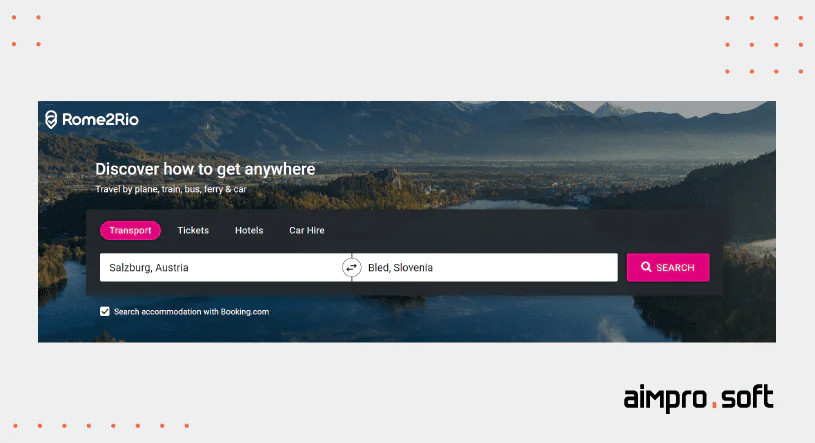 Multimodal transport search engine Rome2Rio
Multimodal transport search engine Rome2Rio
2.1.2. Flight Fare Finders: Skyscanner, ClearTrip, Momondo
Skyscanner, ClearTrip, and Momondo excel in comparing flight fares from thousands of airlines worldwide. These platforms offer invaluable tools for travelers seeking the best deals on air travel.
2.2. Accommodation Advocates: Finding the Perfect Stay
Hotel booking websites bridge the gap between travelers and accommodations, offering a wide range of options from budget-friendly rooms to luxurious suites.
2.2.1. The Booking Giant: Booking.com
Booking.com is a global leader in the accommodation market, boasting millions of listings worldwide. Its success lies in its affordable pricing, exclusive offers, and broad geographical coverage.
2.2.2. The Sharing Economy Pioneer: Airbnb
Airbnb revolutionized the hospitality industry by introducing a sharing economy model, allowing travelers to stay in unique homes and apartments around the world.
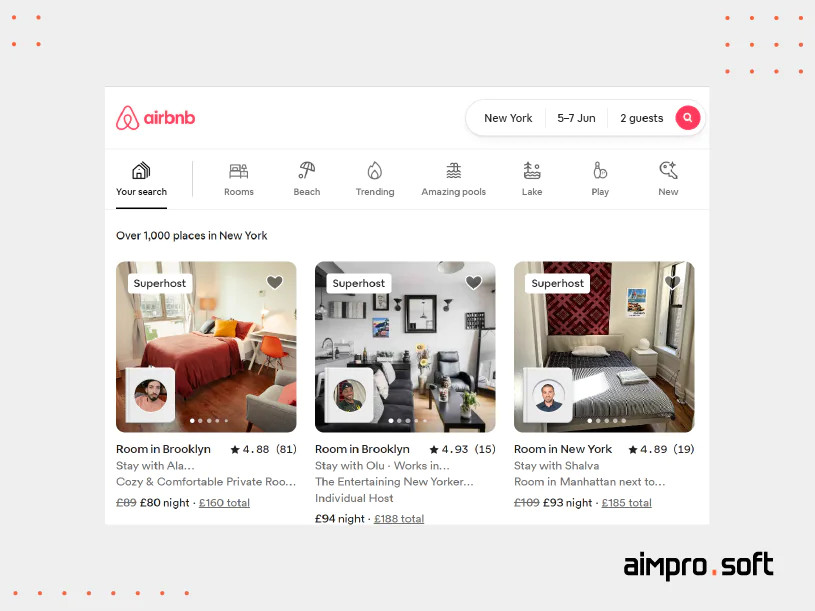 Online marketplace and hospitality service Airbnb
Online marketplace and hospitality service Airbnb
2.2.3. Immersive Cultural Experiences: Couchsurfing
Couchsurfing takes accommodation a step further by connecting travelers with locals offering free lodging, creating immersive cultural experiences.
2.3. Culinary Concierges: Savoring Local Flavors
Food is an integral part of any travel experience. Restaurant booking websites connect travelers with local eateries, allowing them to make reservations in advance and discover new culinary delights.
2.3.1. The Restaurant Reservation Monopolist: OpenTable
OpenTable dominates the online restaurant reservation service market, enabling users to find and book tables at restaurants around the world.
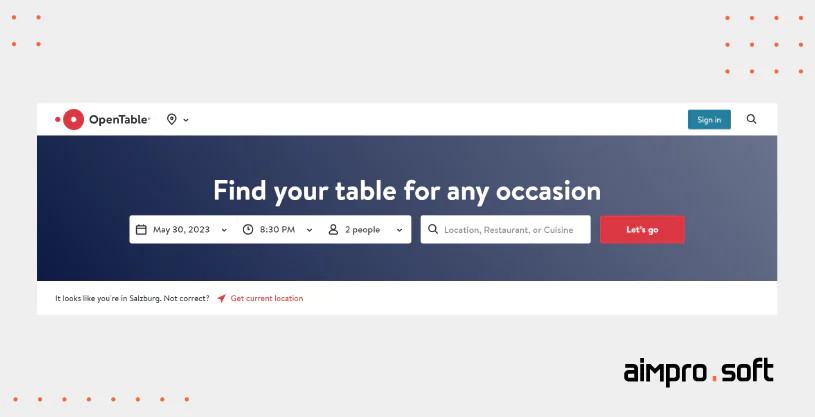 Online restaurant-reservation service OpenTable
Online restaurant-reservation service OpenTable
2.4. Aggregation Aces: Consolidating Travel Options
Travel metasearch engines gather information from various websites, providing travelers with a comprehensive overview of available flights, hotels, car rentals, and activities in one place.
2.4.1. The Fare Aggregator: Kayak
Kayak is a popular travel metasearch engine that compares prices from hundreds of airlines and travel websites, helping travelers find the best deals.
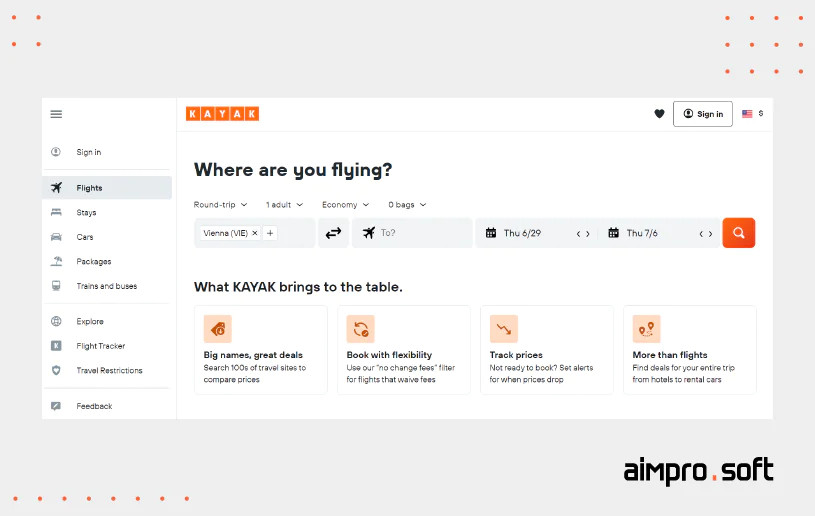 Fare aggregator and travel metasearch engine Kayak
Fare aggregator and travel metasearch engine Kayak
2.5. Entertainment Enablers: Curating Memorable Experiences
Tours and activities websites cater to travelers seeking unique and memorable experiences, offering a wide range of options from sightseeing tours to VIP excursions.
2.5.1. The Tour Website Trailblazer: Viator
Viator is a global online marketplace that provides thousands of curated tours and activities, allowing travelers to book unforgettable experiences.
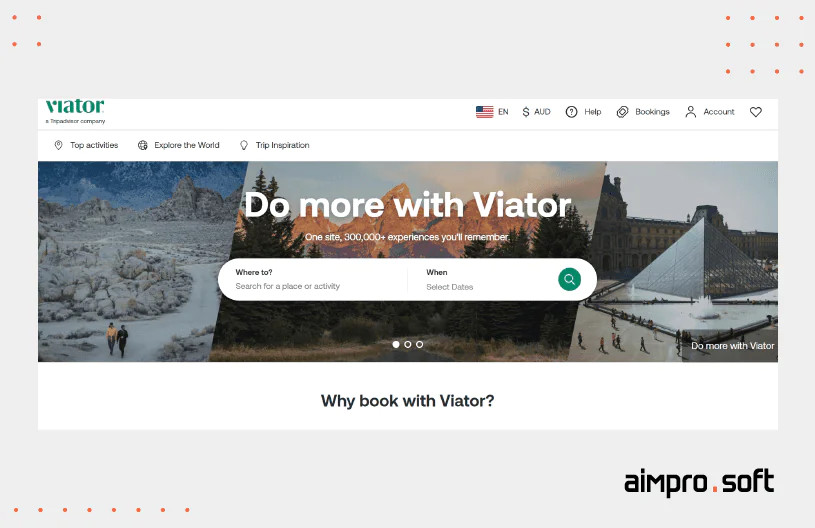 Tours and activities website Viator
Tours and activities website Viator
3. Must-Have Features: Crafting a Successful Travel Website
What are the essential features that will make your travel website stand out from the competition? Focus on user experience, personalization, and seamless functionality.
3.1. Effortless Exploration: Easy Search Filters
According to a study by Google, 70% of travelers prioritize ease of search when planning their trips online. Implementing comprehensive search filters is crucial for enabling users to find their desired options effortlessly.
3.1.1. Granular Filtering: Trip.com
Trip.com exemplifies this with its advanced search filters, allowing users to refine results based on star rating, price range, booking policy, location, payment options, and available amenities.
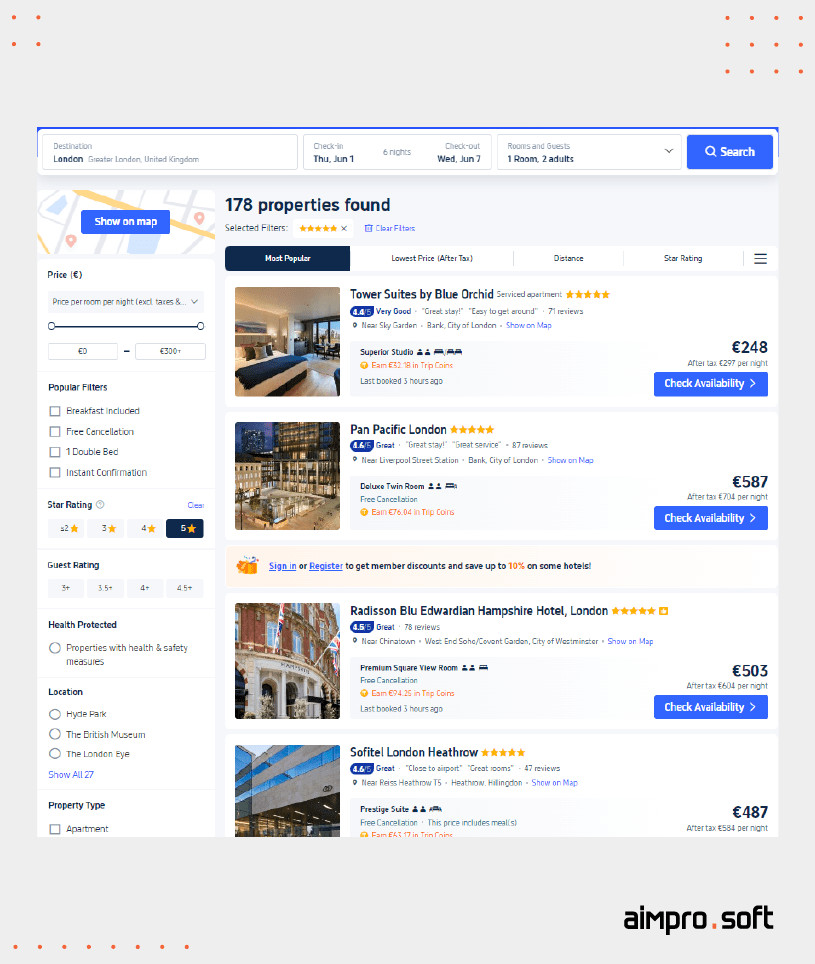 Keywords, star rating, price range and other filters on Trip
Keywords, star rating, price range and other filters on Trip
3.2. Intuitive Navigation: Predictive Search
Predictive search is a valuable feature that enhances user experience by providing instant suggestions as users type in their search queries.
3.2.1. Streamlined Search: Kayak
Kayak’s predictive search functionality exemplifies this, offering relevant suggestions that help users quickly find what they’re looking for.
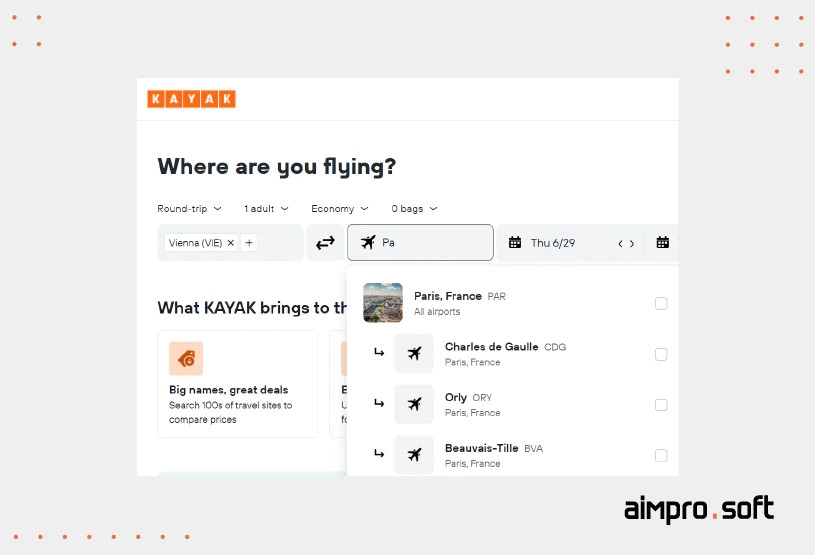 Predictive search on Kayak
Predictive search on Kayak
3.3. Visual Storytelling: Images that Message
High-quality images are essential for capturing the essence of destinations and accommodations, inspiring wanderlust and conveying a sense of authenticity.
3.3.1. Captivating Visuals: Locke
Locke, a design-led aparthotel, masterfully combines high-quality photos with compelling copy, creating a visually appealing and informative website.
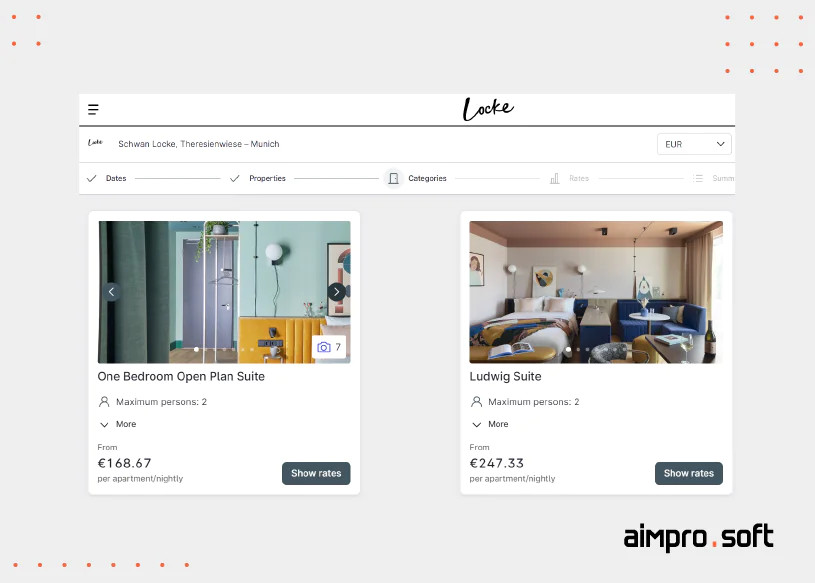 Image gallery on design-led aparthotel Locke
Image gallery on design-led aparthotel Locke
3.4. Building Trust: Customer Reviews
Testimonials and reviews play a crucial role in building trust and credibility, influencing potential travelers’ decisions.
3.4.1. Community-Driven Reviews: Couchsurfing
Couchsurfing leverages testimonials from happy guests to encourage others to join its community, showcasing the positive experiences of its users.
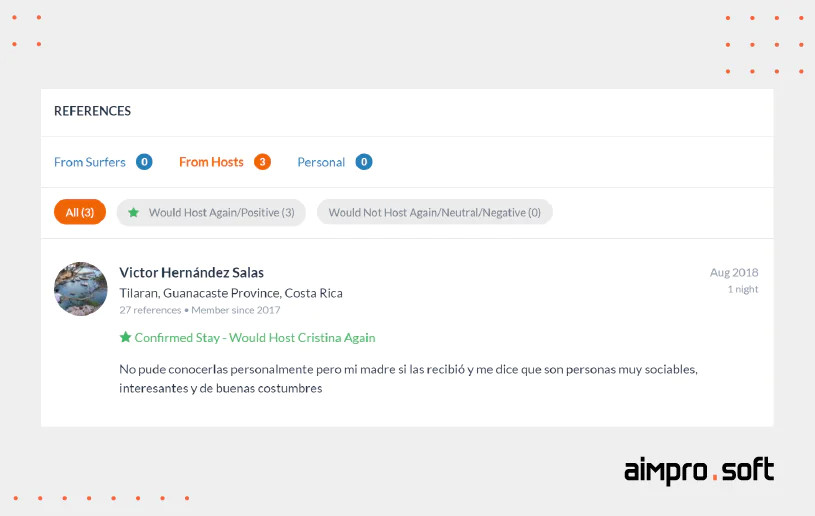 Testimonials of happy guests on Couchsurfing
Testimonials of happy guests on Couchsurfing
3.5. Personalized Planning: Favorites List
Allowing users to save their preferred hotels, places, or activities to a favorites list streamlines their planning process and enhances their overall experience.
3.5.1. Saving Preferences: Travelocity
Travelocity’s “My List” feature enables users to save their favorite options for easy access and future reference.
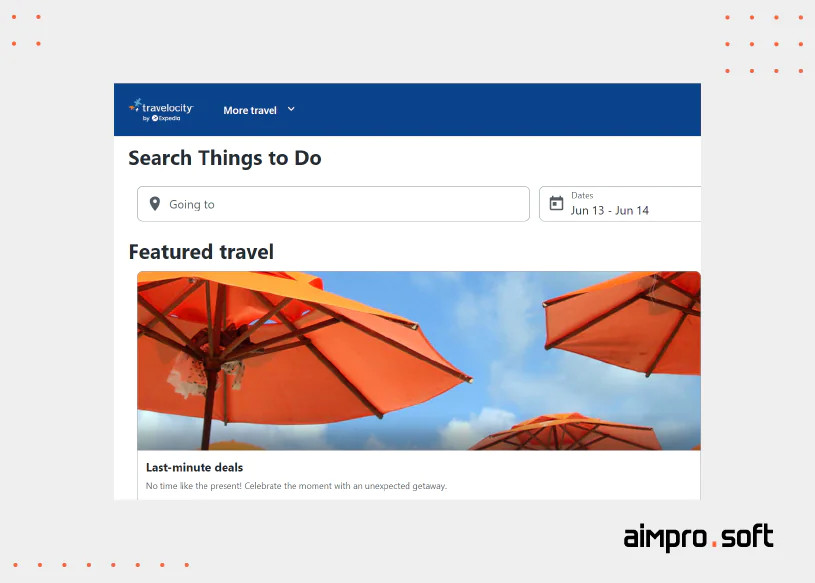 Things to do on Travelocity
Things to do on Travelocity
3.6. Transparent Pricing: Pricing Clarity
Clear and transparent pricing is essential for building trust and avoiding any hidden surprises for travelers.
3.6.1. Honest Cost Breakdown: Travelocity
Travelocity provides a clear breakdown of the services included in its vacation packages, ensuring transparency and building customer confidence.
3.7. Tailored Experiences: Personalization
According to a Google and Phocuswright study, 57% of US tourists believe that online travel providers should tailor website content based on their past behavior or personal preferences.
3.7.1. Customized Alerts: Kayak
Kayak offers personalized price alerts and promo codes in exchange for users’ email addresses, delivering tailored experiences and valuable offers.
3.8. Guiding Actions: Call-to-Action (CTA)
Clear and compelling CTAs are essential for guiding users towards desired actions, such as booking a hotel room or reserving a tour.
3.8.1. Actionable Buttons: Expedia
Expedia utilizes clear CTAs like “Reserve” to encourage users to book hotel rooms, increasing conversions and driving revenue.
3.9. Data-Driven Decisions: Analytics
Analyzing search queries and user behavior provides valuable insights for optimizing website functionality and tailoring offers to meet user needs.
3.9.1. Analytical Insights: Booking.com
Booking.com analyzes user search data to offer personalized travel recommendations, enhancing user experience and driving engagement.
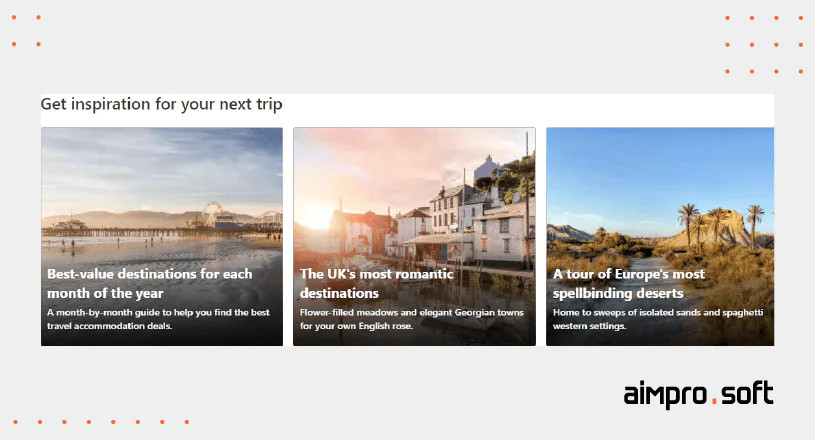 Personalized travel offerings based on analytical data on Booking.com
Personalized travel offerings based on analytical data on Booking.com
3.10. Seamless Support: Customer Care
Providing comprehensive customer support, including FAQs and multiple currency options, enhances user experience and builds trust.
3.10.1. Currency Flexibility: Booking.com
Booking.com offers a wide range of currency options, catering to users from different countries and enhancing their booking experience.
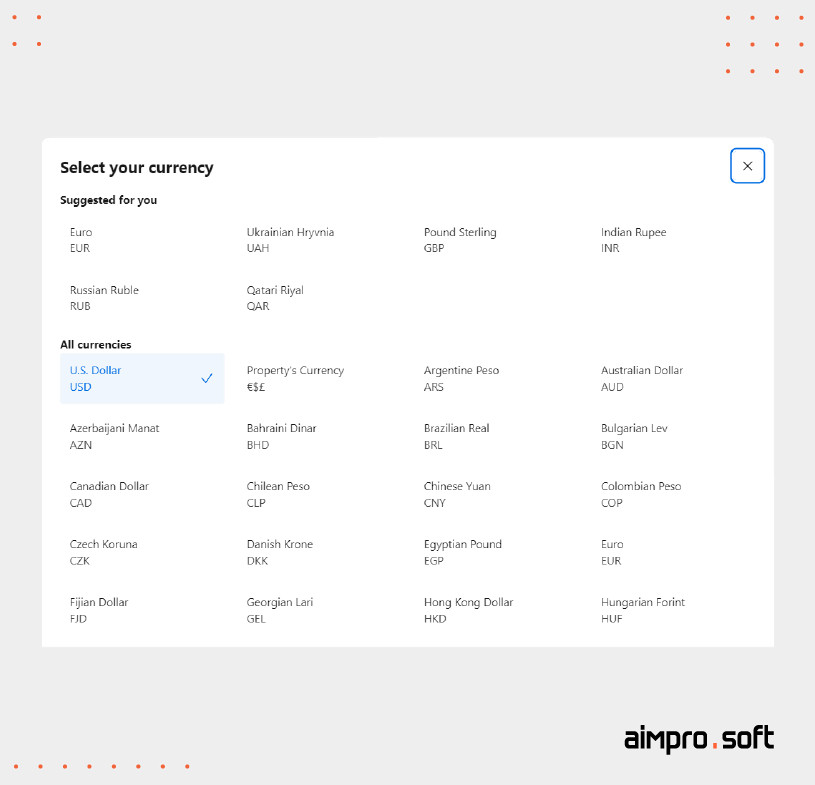 The list of currencies on Booking.com
The list of currencies on Booking.com
3.11. Inspiring Content: Blog
A travel blog is a powerful tool for inspiring wanderlust, providing valuable information, and driving traffic to your website.
3.11.1. Engaging Articles: The Culture Map
The Culture Map exemplifies this with its listicles and educational content, attracting readers with unique and informative articles.
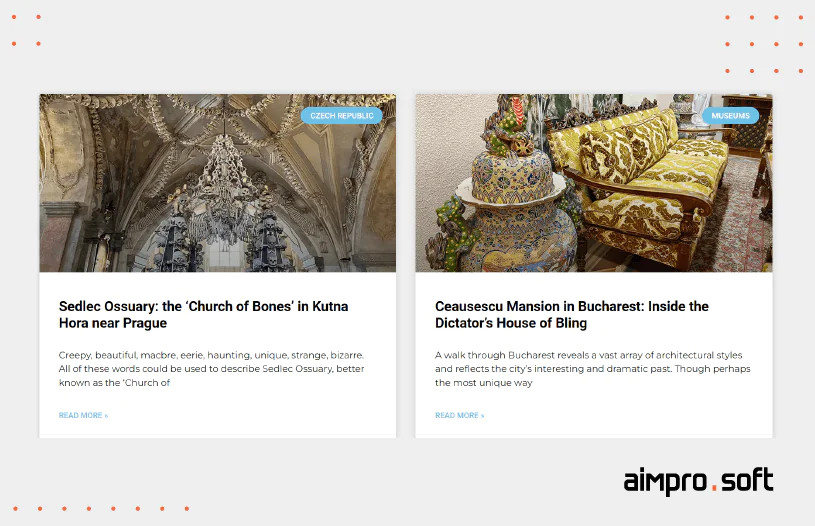 Preview of a listicle on The Culture Map
Preview of a listicle on The Culture Map
3.11.2. Mobile-Friendly Design: Responsive Design
Ensuring your website is responsive and adapts to different devices is crucial for providing a seamless user experience across desktops, tablets, and cell phones.
3.11.3. Interactive Maps: Google Maps Integration
Integrating Google Maps allows users to explore destinations, plan itineraries, and visualize the geographic context of places mentioned in your blog articles.
3.11.4. Real-Time Convenience: Real-Time Online Booking
Enabling real-time online booking directly through your travel portal increases user satisfaction and encourages them to act while their interest is high.
3.11.5. Quick Transactions: Easy & Quick Checkout
A simplified and intuitive checkout process is critical to increasing conversions on your site, ensuring that readers can buy services without too much hassle.
3.12. Reliable Assistance: Access to Customer Help
Providing reliable customer help and support channels, such as chat, chatbots, callbacks, or emails, is essential to resolving any problems or questions your users may have.
4. Business Blueprints: Exploring Winning Business Models
What are the most effective business models for generating revenue in the online travel market? From click-based advertising to commission-based partnerships, there are various options to consider.
4.1. Click-Based Advertising: Pay-Per-Click
This model involves charging advertisers a cost-per-impression or cost-per-click rate.
4.1.1. Kayak’s Approach: Monetizing Clicks
Kayak exemplifies this model, earning revenue for each click that redirects users to advertisers’ websites.
4.2. Transaction Revenue: Direct Bookings
This model involves earning revenue when travelers book hotels or flights directly on your website.
4.2.1. TripAdvisor’s Strategy: Facilitating Bookings
TripAdvisor earns transaction revenue by partnering with hotels and allowing users to book directly through its website.
4.3. Display-Based Advertising: Banner Ads
This model involves selling banner ad space to hotels, cruises, airlines, and tour operators.
4.4. Subscription Model: Exclusive Deals
This model involves offering exclusive deals and benefits to subscribers in exchange for a recurring fee.
4.4.1. Couchsurfing’s Membership: Enhanced Features
Couchsurfing offers a subscription model that provides users with additional features, such as address verification and ad-free browsing.
4.5. Commission: Partnering with Providers
This model involves earning a commission on bookings made through your website.
4.5.1. Booking.com’s Success: Commission-Based Partnerships
Booking.com successfully adopts a commission-based model, earning a percentage of each booking made through its platform.
5. Web Development Wizardry: Partnering with a Web Development Company
Collaborating with a web development company offers numerous advantages, including access to specialized expertise, streamlined development processes, and comprehensive support.
5.1. Market Insights: Business Analysis
Engaging business analysts from a software company provides valuable online travel market insights, uncovering hidden perspectives and identifying upcoming trends.
5.2. Quick Launch: The MVP Approach
Launching a minimum viable product (MVP) allows you to quickly test your business concept, gather user feedback, and iterate on your product.
5.3. Design Matters: UI/UX Optimization
Focusing on both UI and UX design is crucial for creating a visually appealing and user-friendly website.
6. Ten-Step Blueprint: Creating a Travel Website
Creating a travel website involves a series of steps to ensure a functional and attractive online platform.
Step 1: Define Purpose and Audience
Identify your site’s specific niche and target audience, tailoring content and features accordingly.
Step 2: Determine Monetization Strategies
Explore various monetization options, such as affiliate programs, advertising platforms, premium memberships, and sponsored content.
Step 3: Secure Domain and Hosting
Choose a relevant and memorable domain name, and select a reliable web hosting service.
Step 4: Structure Site and Plan Content
Create a clear site structure with intuitive navigation, and plan a content strategy that includes engaging articles, compelling visuals, and practical resources.
Step 5: Design Website
Choose a style and layout for your site, ensuring it is responsive and mobile-friendly.
Step 6: Develop and Integrate Core Features
Implement the agreed-upon functionality, including search engines and social media integration.
Step 7: Integrate Booking and Reservation Systems
Integrate reliable booking and reservation systems to enable users to book flights, accommodations, and other travel services directly on your site.
Step 8: Conduct QA and Testing
Thoroughly test your travel website across different browsers, devices, and screen sizes to ensure it works correctly.
Step 9: Launch Your Website
Set up website analytics to track user behavior, traffic sources, and conversions, and promote your website through various channels.
Step 10: Track, Update, and Improve
Regularly monitor website performance, user engagement, and conversion rates, making necessary updates and improvements.
7. The Balancing Act: Weighing the Pros and Cons
Building a travel website offers numerous advantages, but it also presents certain challenges.
7.1. Advantages:
7.1.1. Global Reach: Reaching a Broad Audience
Creating a travel website allows you to reach a broad audience worldwide, connecting with travelers from different regions.
7.1.2. Earning Potential: Possibilities of Monetization
A well-established travel website can generate revenue through various monetization strategies, such as affiliate marketing and advertising.
7.1.3. Growth Opportunities: Flexibility and Scalability
With a travel website, you have the ability to update and expand your content and offerings as your business grows.
7.1.4. Industry Connections: Network and Collaboration
Building a travel website opens the door to networking and collaboration opportunities with other travel companies, influencers, and celebrities.
7.2. Disadvantages:
7.2.1. Competitive Landscape: High Competition
The travel industry is highly competitive, requiring unique content, strong branding, and effective marketing strategies to stand out.
7.2.2. Technical Expertise: Technical Expertise and Service
Developing and maintaining a travel website requires technical skills or hiring professionals.
7.2.3. External Factors: Dependence on External Factors
The success of a travel website can be affected by external factors such as economic conditions, political instability, and natural disasters.
7.2.4. Content Creation: Continuous Content Creation
Consistent content creation is essential to keep your travel website attractive and relevant.
7.2.5. Customer Care: Customer Service and Support
Managing a travel website often includes handling customer inquiries, providing support, and managing user reviews.
8. Budget Breakdown: Estimating the Cost
The cost of developing a travel website varies depending on various factors, such as the scope of features, complexity, development time, and the location of the development team. A full-fledged website can cost from $150,000 in Eastern Europe to $400,000 in the United States. A minimum viable product (MVP) with basic functionality can range from $31,000 in Eastern Europe to $83,000 in the U.S.
9. Top Performers: The Best Travel Websites
What are the best travel websites in the industry? Let’s take a look at some of the top performers, according to SimilarWeb.
9.1. Booking.com: The King of Online Travel
Booking.com is ranked #1 as the most popular website in the Travel & Tourism category, offering information about over 2 million properties in over 225 countries worldwide.
9.2. TripAdvisor: The Travel Advice Guru
TripAdvisor comes in second on the list, helping users plan their next trip based on reviews and travel advice from the community.
9.3. Airbnb: The Vacation Home Expert
Airbnb takes third place in the rating, offering vacation homes and condo rentals around the world.
 Online marketplace and hospitality service Airbnb
Online marketplace and hospitality service Airbnb
9.4. Expedia: The Well-Known OTA
Expedia is the Top travel and tourism site, ranked #4, offering a wide range of travel services, including flights, hotels, and car rentals.
9.5. Agoda: The Hotel and Resort Specialist
Agoda focuses on hotels and resorts, offering a wide selection of accommodations in Asia and beyond.
10. SIXT.VN: Your Partner in Travel Website Success
Ready to embark on your travel website journey? SIXT.VN is here to guide you every step of the way. From initial planning to ongoing maintenance, we provide expert support and tailored solutions to help you create a successful travel website that meets your specific needs and goals. Visit SIXT.VN today to learn more about our services and start building your dream travel website. Address: 260 Cau Giay, Hanoi, Vietnam. Hotline/Whatsapp: +84 986 244 358.
SIXT.VN offers:
- Expert Travel Consulting.
- Airport Pick-up Services.
- Hotel Booking Services.
- Hanoi Tour Bookings.
Frequently Asked Questions
What are the Key Features for Travel Websites in 2024?
In 2024, key features include 3D tours, enhanced domestic travel content, interactive quizzes, and virtual experiences to engage digital travelers.
How Can I Effectively Market a Travel Website in 2024?
Effective marketing involves leveraging Facebook and Instagram for inspiration, focusing on domestic travel, and utilizing both online and offline ads. According to research from HubSpot, in 2023, companies using social media marketing are 58% more likely to see increased lead generation, making it an essential tool for travel websites.
What Are the First Steps to Create an Online Traveling Website?
Start by offering online walking tours, showcasing 360-degree VR movies, and incorporating user accounts with payment options and favorites.
Is Now a Good Time to Start a Travel Website?
Yes, as the travel industry recovers, now is an opportune time to prepare for the next era and create a brand-new digital presence.
How Do Travel Websites Typically Generate Revenue?
Travel websites generate revenue through direct tour sales, affiliate marketing, banner advertising, sponsored content, booking fees, premium memberships, and analytics sales.
How Can SIXT.VN Help Me Create a Successful Travel Website?
SIXT.VN provides expert guidance, tailored solutions, and comprehensive support to help you create a successful travel website that meets your specific needs and goals, enhancing user experience and increasing bookings.
SIXT.VN is committed to providing you with the latest insights and innovative solutions for creating a thriving travel website. Let us help you unlock the potential of the digital travel market and connect with travelers worldwide.



